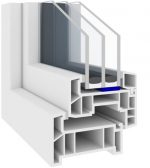Glued windows for better protection from burglaries
The last crime figures show that the police registered exactly 167,136 burglaries in Germany last year. Which means that another flat is ransacked every three minutes on average. Doors and windows are frequently exploited vulnerabilities for break-ins. But the protection from burglars can be markedly improved by gluing.
The annual number of burglaries has been on the increase again for a while, most recently by nearly 10 percent in 2015. The perpetrators very often break into flats and houses by prying open a window. A simple screwdriver will suffice to do this with standard windows. Leverage is applied to design-related vulnerabilities: the connections between the glazing and casement, between the casement and window frame, and between the window frame and wall.
Tested resistance classes
A remedy is provided by anti-burglary windows with demonstrably tested resistance classes. Which is also why the police is recommending components rated RC2 or higher. But a window will only prevent intrusion if the safety chain formed by the bonding of the glass, rebate area and connection to the wall is completely closed and the entire system meets the requirements of the desired resistance class.
Glued all around
What this means for the glass bonding is that glass strips need to be screwed or glued in place to make the grade. A far better solution for this is to glue the insulating glass into the casement, however, because the circumferential bond will fuse them into a single entity.
Only a small number of glazing blocks will now be required for load transfer, if any at all. This eliminates a leverage point for prying the window open at the glass joint. The gluing additionally improves the statics of the entire casement, which is rendered torsion-resistant and virtually impossible to twist. The consequence: A burglary tool applied to only a single point of the window will be unable to gain enough leverage for bending the casement. The gluing hence not only strengthens the glass joint, but indirectly also the connection between the casement and window frame.
The recommended RC2 resistance class is furthermore reached with particular ease if the insulating glass is glued to the casement. This offers tangible advantages for window makers and fitters: The blocking is reduced or even done away with entirely, with no separate fastening of glass strips required. All the window needs now is the right RC2 fitting, and appropriate installation at the building site. In addition, this can also be done using profiles with no additional steel reinforcements.
Polyurethane glue meets the requirements
To be recommended as an optimal antiburglary solution is the gluing position at the base of the rebate with a polyurethane adhesive called Ködiglaze P from Kömmerling. This can not only be used for RC-gluing to plastic profiles, but also all the other commonly used frame materials such as wood, wood/aluminium and aluminium, for example. The glue is available in a one-component version in 600 ml sausages or also in a two-component version for application with mixing and dispensing systems.
Glued to the rebate base
The bonding with the rebate base achieves the best statics: As opposed to glass edge bonding, the casement will not require additional overlaps for reinforcement. The PUR adhesive furthermore achieves a high mechanical stability and is hard to cut. It can even be used to provide RC2-compliant fixed glazing directly at the building site. The one-component adhesive is easy to handle, enabling the insulating glass to be glued into the ready-assembled frame on site without difficulties.
To ensure a permanently secure bond, the manufacturer’s adhesives are compatible with most insulating glass sealants available on the market. This also means that they are attuned to the commonly used polysulphide- or polyurethane-based insulating glass sealants in their chemical as well as mechanical properties. These materials are furthermore compatible with the commercially available PVB films used to increase the glazing’s anti-burglary effect from resistance class RC2.




